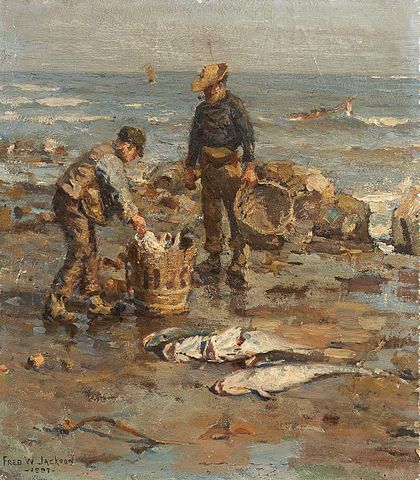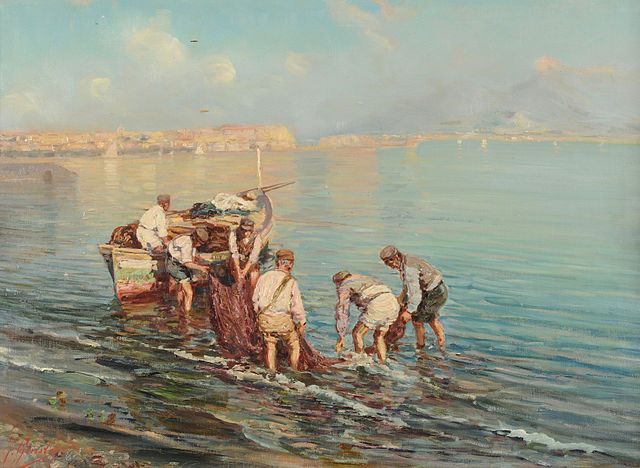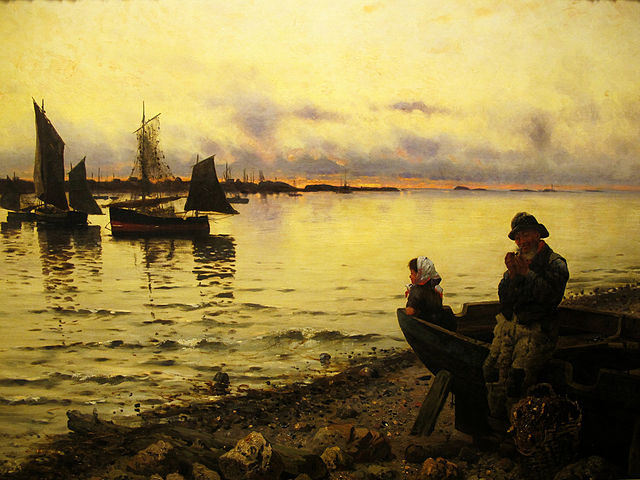
The Old Man and the Sea (1952) is one of the most popular fictional works by the American author Ernest Hemingway.
It is often studied in classes for non-native English speakers because it is short and generally features plain vocabulary and simple declarative sentences. It is also a famous book, having won a Nobel Prize for its author, and was adapted as a film and on television. Because it is set in Cuba, where an old fisherman fights to catch a giant marlin in the Gulf Stream, there are also some Spanish words in the book. Its consciously primitive approach that is not like standard written or spoken English. If you try to read Hemingway’s prose aloud, it sounds mannered, not like real people talking. Hemingway was celebrated for his tough-guy way of writing with short sentences even when this seems exaggerated and unreal. Biographers of the writer have shown that in real life, he was not a self-confident macho man. Problems with alcohol and depression eventually led to his suicide at age 61. Still, many readers have enjoyed the story of Santiago, the old fisherman and a young boy, Manolin, who helps him despite the old man’s inability to catch fish. Since Santiago is plainly unlucky, people in his village try to avoid him. The bad luck continues; although Santiago catches a tremendous fish measuring 18 feet long, sharks eat it before he can return home. Manolin promises to continue to assist the old man in future fishing trips.
Critical reception.
When The Old Man and the Sea first appeared, its publisher compared it to other fiction about hunting, such as William Faulkner’s The Bear and Herman Melville’s Moby-Dick. Yet The Old Man and the Sea is much simpler and more direct than these works. Indeed, Hemingway was not an admirer of the poetic language of Melville, and Faulkner did not enjoy Hemingway’s writing style which mainly presents facts and is uninterested in imaginative matters. The American literary critic F. W. Dupee suggested that The Old Man and the Sea is a
first-rate example of that literature of the big hunt to which so many American writers have contributed, affirming through this image the frontier virtues and the natural basis of our life…The Old Man and the Sea is no such elaborate performance as Moby-Dick or Faulkner’s The Bear, two eminent narratives of the big hunt…Its simplicity is of an urgent kind, like that of a cry of alarm at night or a command shouted across water.

In 1962, Janet M. Cotter, head of the English Department at the San Leandro, California High School, wrote about teaching The Old Man and the Sea to her classes. In Ms. Cotter’s experience, even her less intelligent students appreciated the book: One boy in a so-called ‘slow’ section commented last year, I have never known such love as there is in this book. It’s warm and good.
The student was probably referring to the devotion of Manolin who helped Santiago even after his parents to stay away from the unlucky old man.
Another student in the same class stated: I would like to be as alive as this old man is when I am his age.
This student felt that although Santiago was old and considered unlucky by everyone, he did not give up. He still felt that a big fish would be out there for him to catch one day. Even after he found it and it was destroyed by sharks before he could bring it back to shore, he was still determined to try again in future. This kind of determination in the face of defeat is easy to admire. Since these appreciations came from students who were not successful in school, they were in some ways comparable to Hemingway’s failed fisherman. When young people are told about how a book won great prizes and is famous and loved everywhere, they may feel confused or unhappy if they do not see anything in it to admire for themselves. It may be better not to announce how many awards Hemingway won, but instead focus on the story itself as something of interest and value.

Hemingway’s fame as a distraction.
While Ms. Cotter discussed with her pupils the biographical myth of Hemingway as a fan of bullfighting, African safaris, and deep-sea fishing, this kind of information is not necessary for appreciating The Old Man and the Sea. Hemingway became such a world-famous celebrity that even today, an annual Hemingway Look-alike contest in Key West attracts over one hundred white-bearded men who compete to see who looks the most like Hemingway. This kind of diversion has nothing to do with the basic merit of The Old Man and the Sea. Instead, Ms. Cotter asked her class questions such as:
What things does the boy say and do which show how he felt toward the old man?
Why does the old man say, ‘No man is alone on the sea?’
What colors does Hemingway use to describe the great fish when it first surfaces? Copy any part of the description which you particularly like.
Who does the old man blame for the loss of the fish?
There are no wrong answers to these sorts of questions, and they may help readers pay closer attention to what goes on in the story itself.
Fishing in Thailand
Thai readers can have a special understanding of the sufferings of poor Cuban fishermen, since the Thai government has been working to lessen the sufferings of workers in the Kingdom’s fishing industry. This year, a press conference was held by Mr. Don Pramudwinai, Deputy Minister of Foreign Affairs, Chairman of the National Sub-committee on Law, Partnership and Awareness Promotion on Trafficking in Persons. The subject was Thailand’s Trafficking in Persons 2014 Country Report. Thailand’s Anti-Human Trafficking Act B.E. 2551 (2008) requires related governmental agencies to report annually on the country’s progress and development in fighting human trafficking. Among the achievements in 2014 was registering about 1.6 million illegal migrant workers in 87 registration centers, to better protect them from exploitation and human trafficking. In 2014, the minimum age for working at sea was raised to 18 years, to prevent the exploitation of young people. In 2014, 595 victims of trafficking were identified, 280 cases investigated, 115 cases prosecuted, and 104 defendants convicted. The Deputy Minister of Foreign Affairs declared:
Thailand recognizes that, having made much progress in 2014, many challenges still remain to be dealt with. Our annual report on trafficking in persons is therefore not only to explain the situation to the public, but also to stimulate government authorities to strive for better solutions.

Attempts made.
Due to labor shortages, finding workers for the Thai fishing industry who are not victims of human trafficking has proven a challenge. A suggested plan to give career training to prisoners by associating them voluntarily with the fishing industry under the protection of current laws, was not adopted.
As The Nation reported in January, such international organizations as Human Rights Watch had criticized the plan. With ongoing challenges still to be fully resolved, Thai readers can appreciate The Old Man and the Sea in the context of hardships for people who work on the lower levels of the fishing industry. A special section of the Pridi Banomyong Library is dedicated to studies of human trafficking and the progress being made to resolve this significant problem.
(all images courtesy of Wikimedia Commons).
